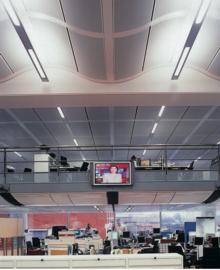Moving beyond indifferent lighting

Lighting is an integral part of the ‘shop-front’ concept of the BBC Mailbox in Birmingham, which enables visitors to see into the radio studios, the editing suites, the drama studio and TV studio stacked on one side of the entrance. On the other side at the upper level, the space flows into the open-plan offices.
In areas with low ceiling heights, a custom recessed solution is used. In the double-height space, an integrated direct/indirect solution is used.
The project has won a Lighting Design Award
PROF. PETER BOYCE explores why so much lighting in commercial buildings in the UK is indifferent and what can be done about it.There is a wide diversity of lighting practice, and there will always be some who are willing to pay for haut couture lighting provided by talented designers. However, the majority do not see any need to go beyond functional lighting.
Why? The problem is not technical. We have a wide range of technologies available — and the skill to use them. No, the problem is justification of the additional expenditure. There are five key factors making for good visibility. • visual size • luminance contrast • colour difference • retinal image quality • adaptation luminance Likewise, there are five main causes of visual discomfort. • excessive non-uniformity • glare — direct, reflected, and overhead • veiling reflections and highlights • shadows • flicker and sparkle So it is clear that whether discomfort occurs or not will depend on the context. Lighting schemes can be classified as bad, indifferent and good. In the UK, most are indifferent. Achieving good visibility and avoiding visual discomfort are actions necessary to provide indifferent lighting, — but are not sufficient to guarantee good lighting. Anyone considering the lighting of a space faces two main impediments — disbelief and legislation. The lack of belief in the benefits of lighting beyond visibility and visual comfort is partly our own fault. For too long we have content to chant, ‘Better lighting leads to higher productivity,’ as if this was obviously true, in all circumstances. However, for many people, their own experience tells them this is not true — hence the disbelief. Legislation and regulations are being introduced that have an impact on lighting practice and written by people who have little interest in lighting — e.g. Part L of the Building Regulations. This is a reflection of the greater priority being given to the collateral damage of lighting (such as energy consumption, light pollution and waste disposal) than to lighting itself. This, too, is linked to the lack of knowledge of the benefits of lighting. So first, we need to educate ourselves about the benefits of lighting beyond visibility and visual comfort. We cannot promote the benefits of good lighting if we do not understand them. Then we need to educate the purchasers and users of lighting about its benefits beyond visibility and visual comfort. If lighting continues to be purchased on the basis of lowest cost or value engineering, we shall never be able to lift standards. In addition, we need to educate the legislators and regulators about the benefits of lighting beyond visibility and visual comfort. It does not matter how necessary energy efficiency may become: there is no point putting in lighting if it is not fit for purpose. So we need to refine what we say about lighting, visibility and productivity. We need to switch our attention from lighting as it affects what people can do to lighting as it affects what people choose to do. We also need to clarify how lighting affects human health — and there is still a lot of work to be done here before we shall be clear enough ourselves about the effects to apply them in normal lighting design. Finally, we need to claim daylighting as our own. Task performance is not the same as visual performance. Lighting that alters visibility will change the performance of tasks that are limited by visibility but not those that are limited by cognitive factors. Lighting conditions that change the appearance of the space but do not affect the visibility of the task may or may not affect task performance. The hypothesis is that good lighting will attract better people, who will stay longer — i.e. it will change what people choose to do. Integrating daylight and electric lighting is desirable for three reasons. Lighting practice then covers all aspects of lighting; it acknowledges the concerns about energy — and people love daylight. For lighting practice to have some say over how daylighting is achieved, it is necessary to demonstrate some expertise. This means recognising that good daylighting involves the control and distribution of light over a wide range of conditions, and consideration of the view out. The future of lighting practice will be determined by the extent to which we educate ourselves, our customers, users of lighting and legislators about the benefits of lighting, beyond visibility and visual comfort. This means: • understanding of how light affects health; • demonstrating competence in the design of daylighting and integrating it with electric lighting. If we limit ourselves to visibility and visual comfort, lighting will become a commodity — like toilet paper. Lighting will be flushed down the pan of indifference. Innovation will falter, and boredom will prevail. What a wasted opportunity! If we achieve the above aims, the future of lighting practice is bright.
This article is based on Prof. Boyce’s Trotter-Paterson lecture delivered earlier this year.
Related articles:








